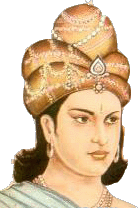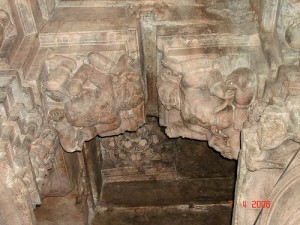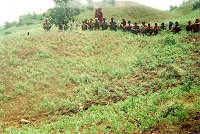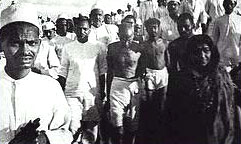Koli, Mandhata (कोली, कोरी, कोल)- Aboriginal tribes of India
 Ashoka The Great from Koli Tribe
Ashoka The Great from Koli Tribe
हम कौन हैं मेरे पुरखे कौन थे वे कहाँ से आए थे वे कैसे रहते थे
(‘Who am I? Who were my forefathers? Where did they come from? How did they live?)
Download this page in PDF format: Download History of Koli/Kori/Mandhata
In studying the aboriginal tribes of India, scholars have consulted our most ancient records and documents – the Vedas, the Puranas, the epics in different languages, many archaeological records and notes, and various other publications.
Students of history and anthropology have found numerous instances recorded in
all prehistoric and established history of India, of a glowing past of this ancient tribe of India and more is being uncovered as research continues.
This article is based mainly on three publications written in Gujarati. An Ancient Tribe of Bharat – The History of Koli Tribe’ a book edited by Shree Bachoobhai Pitamber Kambed and published by Shree Talpoda Koli Community of Bhavnagar (First Edition 1961 and Second Edition 1981), an article by Shree Ramjibhai Santola published in Bombay
Samachar in 1979 and a lengthy paper prepared by Dr. Arjun Patel in 1989 for presentation at the International Koli Samaj Conference in 1989.
The most ancient King Mandhata, a supreme and universal ruler whose reputation spread far and wide throughout India and whose stories of valor and yajna were described in the stone carvings of Mohanjo Daro, belonged to this tribe.
The most ancient and revered sage Valmiki, the author of Ramayana belonged to this tribe.
 |
| Koli Valmiki Ramayana |
Even today Ramayana is referred to as Koli Valmiki Ramayan in Maharashtra State. Teachings from Ramayan form the basis of Indian culture.
The great king Chandra Gupta Mourya, and his line of descendant kings belonged to the Koli tribe.
Lord Budhha’s mother and his wife belonged to the Koli tribe. Sant Kabir, a weaver by trade, ended several of his ‘bhajans’ as ‘kahet kabir kori’ was a self-confessed Koli. Bhaktaraj Bhadurdas and Bhaktaraj Valram from Saurastra, Girnari Sant Velnathji from Junagadh, Bhaktaraj Jobanpagi, Sant Sri Koya Bhagat, Sant Dhudhalinath, Madan Bhagat, Sany Kanji Swami of 17th and 18th Century all belonged to the Koli tribe.
Their life and reputation were described in books of their life and in articles published in Mumbai Samachar, Nutan Gujarat, Parmarth etc.
In the State of Maharashtra, Sivaji’s Commander-in-Chief and several of his Generals belonged to this tribe. ‘A History of the Marathas’ note with pride the bravery of Sivaji’s army consisting mainly of Mavalis and Kolis. His General, Tanaji Rao Malusare, who was always referred to by Sivaji as ‘My Lion’ was a koli. When Tanaji fell fighting for
and winning the ‘Kodana Fort’, Sivaji renamed the fort as ‘Sinhghadhh’ in his memory.
In the 1857 uprising a number of Koli women fighters played an important role in trying to save the life of the ‘Rani of Jhansi’. Among them was a very close colleague of the queen named Jhalkari. The Koli Samaj, thus, has given India and the world, great sons and daughters whose teachings are of universal import and of relevance to modern day living.
 |
| Mandhata Temple of Onkareshwar |
Legend of our Ancient King Mandhata
the Kshtria Caste. They are: Malla, Janak, Videhi, Koliye, Morya, Lichchhvi, Janatri, Vajji, and Shakya.’
Archaeological findings, when pieced together, show Mandhata as belonging to Ishvaku – Sun Dynasty and his descendants were known as ‘Sun Dynasty Koli Kings’. They were known to be brave, illustrious and just rulers. Buddhist texts have numerous references proving this beyond doubt. The descendants of Mandhata played a vital role and our ancient Vedas, epics and other relics mention their important contributions in the art of war and state administration. They are referred to in our ancient Sanskrit books as Kulya, Kuliye, Koli Serp, Kolik, Kaul etc.
Early history – After Buddha
The teachings of Lord Buddha were seen as a threat to vested interests of the upper-caste Hindus. Soon, the teachings of Buddha was completely banished from India.
It appears that Koli Kingdoms with their relationship and affinity to Buddha suffered most from this persecution. Although the vast majority
never embraced Buddhist teachings, they been cold shouldered by others and suffered neglect from the rulers.
2000 Years After Lord Buddha
society, a once powerful tribe, hardworking, skilled, loyal, self-sufficient but easily provoked into war, lost its central position.
A tribe that founded and built Bombay – named after the name of their Goddess, Mumba Devi, finds it hard even to this day to get into positions of political or academic influence. For centuries now, other tribes have looked down upon them and the resulting psychological effects were devastating for this entire community of Kshtrias.
The Present
| Koli Fishermen of Maharashtra |
Kolis of Gujarat
this to be so at the time of ruler Vanraj some 600 years ago. The very diverse ethnic groups represented now in the Gujarati population is said to be Vedic or Dravidian. These include the Nagar Brahman, Bhatia, Bhadela, Koli, Rabari, Mina, Bhangi, Dubla, Naikda, and Macchi-Kharwa tribes. Parsis, originally from Persia, represent a much
later influx. The rest of the population is the Adivasi Bhil tribe.
 < < |
| Bhils of Gujarat |
While Kolis and Bhils may have been the original inhabitants of Gujarat they lost ground to the later arrivals and most likely settled near the coast and hills.
Kolis in particular with their affinity to Buddha suffered severe discrimination in earning a living. As an original Kshritya fighting caste, their one characteristic of being easily provoked to fight did not help. They may also be described as ruggedly individualistic more so at that time then now. For majority of them life even two hundred
years ago was one of severe hardship, bonded labor and indignity. That was the price they paid to submission.
 |
| Dandi March |
In Conclusion
We have thousands of graduates and professionals, highly qualified doctors, dentists, lawyers, and skilled technocrats, living in their adopted countries and in India. They all seem to be using their skills to make money and in a race to acquire material goods and other minor pleasures. Material comforts are necessary but our priority must also be to safeguard and protect our religion, culture and tradition.
The Indian Encyclopedia
http://en.wikipedia.org/wiki/Kol_people
http://en.wikipedia.org/wiki/Kori_caste
http://en.wikipedia.org/wiki/Koli
http://www.indianetzone.com/37/indian_aboriginal_tribes.htm
http://www.encyclopedia.com/topic/Kol.aspx
http://akhilbhartiyakolisamaj.org/
http://meghnet.blogspot.com/2011/01/kolikori-of-india-we-call-them.html
मेघवंश एक सिंहावलोकन : लेखक आर. पी. सिंह (पीडीएफ पाठ)
Other links to the topic:
The Bible of Aryan Invasion
http://en.wikipedia.org/wiki/Jyotirao_Phule
http://www.hinduonnet.com/fline/fl1720/17200040.htm